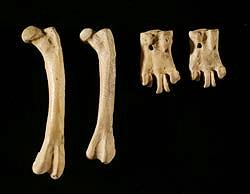 紐西蘭發現並鑒定出至少已滅絕500年以上的企鵝品種。
紐西蘭發現並鑒定出至少已滅絕500年以上的企鵝品種。
由奧塔哥大學、阿德雷德大學以及坎特伯里博物館共同組成的生物研究團隊鑒定、並命名的「瓦塔哈企鵝」(Waitaha penguin)曾經棲居在紐西蘭南島的海岸上。
科學家著手調查自人類定居紐西蘭至今,瀕臨滅絕的黃眼企鵝在數目上改變,卻吃驚地發現過去未知的企鵝品種。
由奧塔哥動物學博士生玻森庫(Sanne Boessenkool)領軍,研究者們利用史前動物骨骼中遺留的DNA,結合像是骨骼架構研究等傳統技術,鑒定出已經滅絕的偉塔哈企鵝。
玻森庫表示:「根據推測,這種瓦塔哈企鵝大約在公元1300到1500年間滅絕,就在波里尼西亞人大舉移民於此定居之後。」 她並且說道:「這種企鵝的滅絕連同毛利(Maori)文化在掠奪者進入時的更動與轉變,為黃眼企鵝在500年前開創佔領紐西蘭主島的契機。」
 此團隊成員之一、也是阿德雷德大學澳洲古DNA中心代理主任的奧斯丁博士(Dr. Jeremy Austin)表示:「我們的發現證明了我們過去所知有誤,原來目前紐西蘭主島上的黃眼企鵝並不是過去為數眾多、到如今才凋零殘留的一群。黃眼企鵝是來自亞南極區的新客,取代了現今已滅絕的瓦塔哈企鵝。」
此團隊成員之一、也是阿德雷德大學澳洲古DNA中心代理主任的奧斯丁博士(Dr. Jeremy Austin)表示:「我們的發現證明了我們過去所知有誤,原來目前紐西蘭主島上的黃眼企鵝並不是過去為數眾多、到如今才凋零殘留的一群。黃眼企鵝是來自亞南極區的新客,取代了現今已滅絕的瓦塔哈企鵝。」
他進一步說明:「之前的化石紀錄和其他傳聞證據分析顯示,過去黃眼企鵝數目更多,分布範圍更廣,但是依照目前的發現看來,牠們在這個島上也不過500年左右而已。」
玻森庫表示:「我們發現已滅絕的品種和黃眼企鵝關係密切,根據目前的推測,黃眼企鵝應該是來自亞南極的奧克蘭地區與坎貝爾群島的新來客。」
奧斯丁博士提到:「當初這兩種企鵝之間的競爭可能阻擋了黃眼企鵝往北推進。但是天敵數目造成的環境變遷,像是海獅的大量減少,可能促進了黃眼企鵝在南島的進展。」
如今黃眼企鵝是世界上最稀有的企鵝品種之一,大約只剩下7千隻棲居在紐西蘭。
黃眼企鵝也是世界上第三大的企鵝品種,為重點保育動物。牠們面臨的主要威脅包括棲地惡化、新引進的天敵、以及環境變遷。
該團隊的研究發現已經在週刊登於國際生物學研究期刊《皇家學會學報B部份:生物學專刊》(Proceedings of the Royal Society B: Biological Sciences)。
A species of penguin that has been extinct for at least 500 years has been discovered and identified in New Zealand.
Named the Waitaha penguin by a team of biologists from the University of Otago, University of Adelaide and Canterbury Museum, the newly identified penguin once lived on the shores of New Zealand's South Island.
The scientists had set out to investigate changes in the population of the endangered yellow-eyed penguin since human settlement in New Zealand and were startled to discover the previously unknown penguin species.
Led by Otago Zoology PhD student Sanne Boessenkool, the researchers identified the extinct Waitaha penguin using ancient DNA from prehistoric bones, combined with traditional techniques, such as studying bone structures.
"It is estimated that the so-called Waitaha Penguin became extinct between 1300 and 1500 AD, soon after Polynesian settlement," she said.
"The penguin's extinction, combined with Maori cultural shifts and changes in predator populations, created an opportunity for the yellow-eyed penguin to colonize New Zealand's mainland around 500 years ago," she said.
"Our findings demonstrate that yellow-eyed penguins on mainland New Zealand are not a declining remnant of a previous abundant population, but came from the sub-Antarctic relatively recently and replaced the extinct Waitaha Penguin," said team member Dr. Jeremy Austin, deputy director of the Australian Centre for Ancient DNA at the University of Adelaide.
"Previous analysis of fossil records and anecdotal evidence suggested that the yellow-eyed penguin was more abundant and widespread in the past, but it now appears they have only been around for 500 years," he said.
"We found that the extinct species was closely related to the yellow-eyed penguin, which is now assumed to be a relatively recent arrival from the subantarctic Auckland and Campbell Islands," Boessenkool said.
"Competition between the two species may have previously prevented the yellow-eyed penguin from expanding northwards," said Dr. Austin, "but environmental changes in the predator population, such as the severe decline of sea lions, might have facilitated their colonization in the South Island."
The yellow-eyed penguin is considered one of the world's rarest penguin species, with an estimated population of 7,000 in New Zealand.
The world's third-largest penguin species, it is the focus of an extensive conservation effort. The main threats include habitat degradation and introduced predators as well as environmental changes.
The team's findings are published this week in the international biological research journal "Proceedings of the Royal Society B: Biological Sciences."







